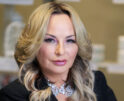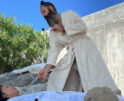
Heart Stopper

Your high-powered career puts you at greater risk for heart disease.
By Michelle Cohen Marill
A deadline is looming, unopened e-mails are piling up and a roomful of people are waiting for you to start the meeting. You skipped lunch, so you grab a soda and a bag of chips. As you balance your briefcase and your snack and head for the elevator, you suddenly feel out of breath, as if you’re struggling to climb a tower of stairs. You feel a little nauseated and a sharp pain stabs you in the chest.
Maybe it’s the junk food on an empty stomach. Maybe it’s an anxiety attack. You don’t even allow yourself to think it could be a heart attack. That’s a problem for overweight, aging men, right?
Wrong. Dead wrong. Heart disease kills more women than men each year. In fact, it’s the No. 1 killer of women, causing more deaths than all kinds of cancer combined (including breast cancer). And it’s not just a problem for the elderly. One in 10 women ages 45 to 64 lives with heart disease.
Remember the image of the Type A male executive keeling over from a heart attack? Today that’s more likely to be a woman. Having a high-powered job almost triples a woman’s risk of developing heart disease, according to the Framingham Offspring Study, a continuation of the well-known Framingham Heart Study. And a Swedish study found that women are six times more likely to have a heart attack if they have a high-pressure deadline at work.
“Whether it’s physical or mental stress, your stressful episode increases your heart rate and blood pressure and increases the oxygen demand on your heart,” explains Alexandra Lansky, M.D., director of clinical services at the Center for Interventional Therapy at Columbia University Medical Center and director of the Women’s Cardiovascular Health Initiative at the Cardiovascular Research Foundation. “That may be your triggering event.”
Silent and Deadly
Pamela Serure of Manhattan never imagined she would be a candidate for the cardiac unit. But stress was a constant in her life – a risk she didn’t recognize. She had a frenzied but exhilarating career in the fashion industry, working as a vice president of licensing for The Gitano Group and developing products for her own children’s designer line. She quit when she began to suffer from rashes and headaches related to a severe environmental allergy. Serure pursued her new dedication to yoga, journaling and nutrition with the same intensity. She created an organic juicing company called Get Juiced, wrote two books, and consulted on lifestyle changes with such celebrities as Barbra Streisand and Christie Brinkley.
She was 47 when she felt a burning in her chest, like indigestion that wouldn’t go away. At first, doctors dismissed her symptoms as a vestige of pneumonia. One doctor said she had angina, a sudden tightness in the chest that isn’t life threatening. Then a CT scan showed a high calcium buildup, an indication of plaque in the arteries and a serious heart attack risk.
Yet her stress test and EKG were normal. She was about to go home from that doctor’s visit when the burning sensation flared up again. She asked for another test. This time, an angiogram showed a 98 percent blockage of the main artery to the heart – the so-called widowmaker (a nickname that points to the male centric view of heart disease) – and major blockage to two other arteries. Doctors rushed her into bypass surgery.
“The shock was overwhelming for me,” says Serure, who, after all, was a model of healthy living. “It took me a long time to stop asking, ‘Why me?'”
Today, at 56, Serure slows her pace and takes time for walks in the country. She founded Events of the Heart, a nonprofit raises money for research and awareness, and promotes her book titled Take It to Heart: The Real Deal on Women and Heart Disease (Broadway, 2006).
But heart disease – and the threat of a heart attack – are constants she must live with. Five years after her bypass, Serure had a heart attack while undergoing a stress test in her doctor’s office. She needed emergency surgery to place another stent in the artery. “There’s an unmistakable feeling when you have some thing about to happen with your heart. It’s an anxiety, an agitation, a kind of dread,” she says. “Something’s wrong and you can’t put your finger on it.”
Listen to Your Body
These are the heart facts: Women fear breast cancer more than any other disease. They know heart disease is a major killer, but they don’t feel personally at risk. They also know what to do (exercise) and what to avoid (smoking and fatty, high-salt foods). But professional women are often just too busy to eat well, exercise or go to a doctor, says Ileana L. Piña, M.D., who treats women with heart disease at Case Western Reserve University in Cleveland. African-American women have an even greater risk, as they’re more likely to have high blood pressure and diabetes.
Add work stress to the mix and the stakes definitely rise. “I think executive and high-powered working women are in trouble,” says Piña, a heart failure transplant cardiologist who herself struggles to make time to exercise. “You really have to make a personal effort to manage these risk factors.”
Surprisingly, professional women can’t always count on their doctors to understand their risks. Only 8 percent of primary care physicians are aware that more women than men die of heart disease, according to a 2005 American Heart Association survey. Nieca Goldberg, M.D., medical director of the New York University Women’s Heart Program, urges women to be proactive about possible symptoms. “I see women who are in executive positions who suddenly don’t feel well and come in, but a lot of this could have been prevented,” says Goldberg, author of The Women’s Healthy Heart Program (Ballantine Books, 2006).
Kathy Kastan, 48, an avid, lifelong athlete, began feeling short of breath when she was running. A sharp, throbbing pain ran from her shoulder down her arm during her swim class. She figured it was just stress or middle age or somehow related to her asthma. In the year before, she had gone through the major life chaneges that would rattle anyone. She had closed her Baltimore psychotherapy practice and moved to Memphis with her husband and three children. Her mother had died, and on the day of the funeral her grandmother had broken both wrists and a hip from a fall. Meanwhile, she was helping her children adjust to life in a new city.
“I started to feel really fatigued,” she says. “I just thought it was all the stress. I never thought for a minute I could have heart disease.”
She waited eight months before seeking medical care, and then was misdiagnosed. In the summer of 2001, she finally received a stent to open up a damaged vessel. Within a few months, the stent closed up; she needed two more stents in that same vessel. One of them caused complications that ultimately led to emergency bypass surgery – at the age of 42. Today, Kastan is past president for the board of WomenHeart , an organization that raises heart health awareness.
“I’m convinced that my [stressful] life impacted my heart. I didn’t have high cholesterol, I didn’t have high blood pressure, I don’t smoke,” says Kastan, whose book, From the Heart: A Woman’s Guide to Living Well with Heart Disease (DaCopa Press, 2007), draws on the stories of 10 women with heart disease.
Kastam has a message for women who are in denial about the risk of heart disease –a lesson she learned the hard way. “It means you have to face things you don’t want to face,” she says “but that are what’s going on to keep us alive and living well.
A Heart-Healthy Check
One in three. Heart disease is responsible for about one-third of all deaths among women each year. But you may be able to improve your own odds by getting an early start on heart health.
Here’s what your physician should check:
Blood Pressure. A reading above 140/90 is high and increases the risk of heart disease.
Cholesterol. LDL should be below 130 mg/dL and HDL should be at 60 mg/dL or above. Triglycerides, which may be even more important for women than for men, should be at or below 150 mg/dL.
Glucose or glucose tolerance test for diabetes. Women with diabetes have as much as seven times higher risk of heart disease.
Family History. Having a mother or sister diagnosed with heart disease before age 65 or a father or brother diagnosed before age 55 increases your risk.
Stress. By itself, stress could be a risk factor for heart disease, but it can also worsen other risks by increasing blood pressure and by making you more likely to smoke, overeat and exercise less.
Body Mass Index. A BMI of 25 or greater increases your risk of heart disease.
Depending upon your risk factors, you also may want to ask your doctor about tests for homocysteine level, lipoprotein (a) and C-reactive protein. These substances have been linked to heart disease. However, the tests are relatively new and may not be covered by insurance.
Are You Having A Heart Attack?
A heart attack doesn’t always strike with the classic jolting pain in the chest. Women often have atypical symptoms as well as some of the more common ones:
Chest Pain. It may feel like chest pressure or even like indigestion. Women are less likely than men to feel chest pain during a heart attack.
Shortness of Breathing. This is a telltale sign and may occur before or during chest comfort. More common in women.
Sweating. This symptom is more common in men.
Pain in the Arm. Many women also report jaw, neck or back pain.
Nausea, Vomiting or Indigestion. More common in women.
Fatigue, Weakness, Dizziness, or Lightheadedness. More common in women.
Want More?
1. goredforwomen.org
Sponsored by the American Heart Association, the site includes online “heart checkup.’
2. womenheart.org
This site of the National Coalition for Women with Heart Disease, a patient advocacy organization, provides news, facts, support networks, recipes and exercise tops.
3. hearthealthywomen.org
The Cardiovascular Research Foundation maintains this site with detailed information on risk, symptoms, and symptoms and treatments.
Recommended
-
5 Skin Care Trends: What Profe...April 10th, 2024
-
Is It Time To Change Your Rela...March 20th, 2024
-
Resilience & Transformati...February 20th, 2024
-
Medical Malpractice Lawsuits: ...October 31st, 2023
-
Be Here Now—Two Easy StepsSeptember 19th, 2023















